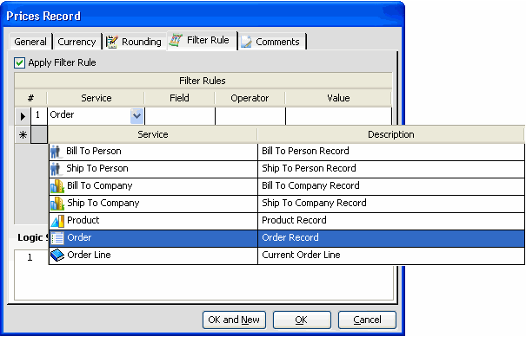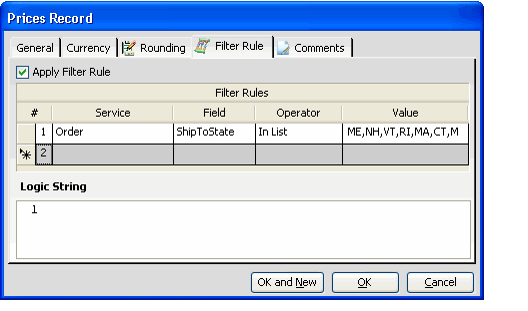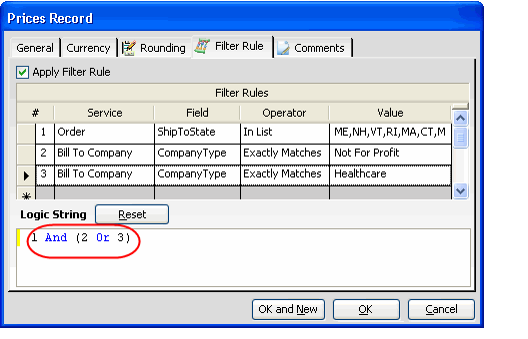Creating Product Filter Rules
You can create one or more filter rules if a particular price only applies to an order line under certain conditions beyond the standard criteria specified on the Price's General tab.
For example, this price may only be available to companies located within a certain set of states, such as an East Coast price. Then, a second corresponding Prices record could exist that specifies a price for West Coast states.
Follow these steps to create one or more filter rules to specify the conditions under which a price may be applied to a product's order line:
Creating a filter rule is very similar to creating a filter for a view.
- Click the Filter Rules tab on the Prices record.
- Select the Apply Filter Rule option.
- Select a Service for the first filter statement.
- You can create a filter statement to determine if an order qualifies for a particular price based on a field in one of the following services:
- Ship To Person: Select this option if the filter statement is based on a property of the Person specified in the order's Ship To field.
- Ship To Company: Select this option if the filter statement is based on a property of the Company specified in the order's Ship To Company field.
- Bill To Person: Select this option if the filter statement is based on a property of the Person specified in the order's Bill To field.
- Bill To Company: Select this option if the filter statement is based on a property of the Company specified in the order's Bill To Company field.
- Product: Select this option if the filter statement is based on a property of the product to which this price may apply.
- Order: Select this option if the filter statement is based on a property of the order that contains the current order line.
- Order Line: Select this option if the filter statement is based on a property of the current order line for the product.
Note Concerning Available Services
Depending on your system configuration not all services listed above may be available. If you want to create a filter for any service not included in your list contact your System Administrator.
- Select a Field in the selected service to use as the basis for the filter.
- The Field drop-down list displays the set of fields contained in the service you selected.
- The fields are listed in the order in which they appear in the entity. However, the fields can be sorted alphabetically (ascending or descending) by clicking the desired Field column heading (Field or Description) to sort by. One click sorts the specified column in alphabetical ascending order. Clicking the column heading a second time sorts the fields in descending order.
- Select the Operator for the filter statement.
- The operator compares the value of the selected Field for each record in the service with the contents of the Value column.
The available options in the Operator drop-down list vary depending on the type of Field selected: text or number.
Field Type
Operators Available
Type of Comparison
Character
Exactly Matches
Field column value exactly matches the characters entered in the Value column.
Contains
Field column value contains the characters entered in the Value column. The characters can appear anywhere in the field.
Begins With
Field column value begins with the characters entered in the Value column.
Ends With
Field column value ends with these characters entered in the Value column.
Does Not Contain
Contents lists in the Value column to do appear anywhere in the Field column value.
In List
Field column value matches one of the values in the Values column; each value is separated by a comma.
Is Blank
Field column value contains no data.
Is Not Blank
Field column value contains any data.
Numeric/Date
=
Equals
< >
Does not equal
>
Greater than
<
Less than
>=
Greater than or equal
<=
Less than or equal
In List
Field column value matches one of the values in the Values column; each value is separated by a comma.
- Enter the Value for the filter statement.
- You enter characters, a phrase, or a number that the system will use as the basis for the filter. The Value field uses the operator selected in the Operator column to determine the type of match.
- In general, you manually enter text or numbers into the Value column, but, in some cases, the system provides you with additional options to facilitate selection:
- For all field types other than Datetime fields, Aptify provides a drop-down list of the first 100 possible values that you can select from. Note that these possible values are only a suggestion: Only the first 100 values appear in the list, even if the field contains more than 100 values. If the field contains less than 100 values, then all of the values appear in the list. You can either select a value from the drop-down list or manually enter a value in the field.
- If you select a field that uses the Datetime format from the Field drop-down list, an ellipsis (…) button appears in the Value field. Clicking this button opens a Date Selection Box.
- For bit fields, you can enter a filter of Field = True or Field = False. The Filter Rule automatically converts this to Field =1 or Field = 0.
- In the figure below, this price is only applied to orders where the Ship To State is in the states listed in the Value field.
- Create additional filter rules, as necessary.
- If you want to delete a filter rule, select the appropriate line and press the Delete key.
- If you want to delete a filter rule, select the appropriate line and press the Delete key.
- Configure the Logic String to join the filters together.
- Just like with multiple view filters, you use Boolean logic to connect multiple filter rules. This includes the following common connectors:
- AND: Restrictive; matches records that satisfy both filter statements
- OR: Inclusive; matches records that satisfy either filter statement
- NOT: Corresponds to records that do not match a filter statement
- By default, multiple filter rules are joined with an AND operator.
- In the figure below, the price applies to an order if the Ship To State is one of the states listed and the Bill To Company's company type is Not For Profit or Healthcare.
- To reset the filter logic to its original setting, click the Reset button.
- Just like with multiple view filters, you use Boolean logic to connect multiple filter rules. This includes the following common connectors:
Click OK to save and close the Prices record.
To disable a filter rule, select the Apply Filter Rule option and save the Prices record.
Copyright © 2014-2019 Aptify - Confidential and Proprietary


